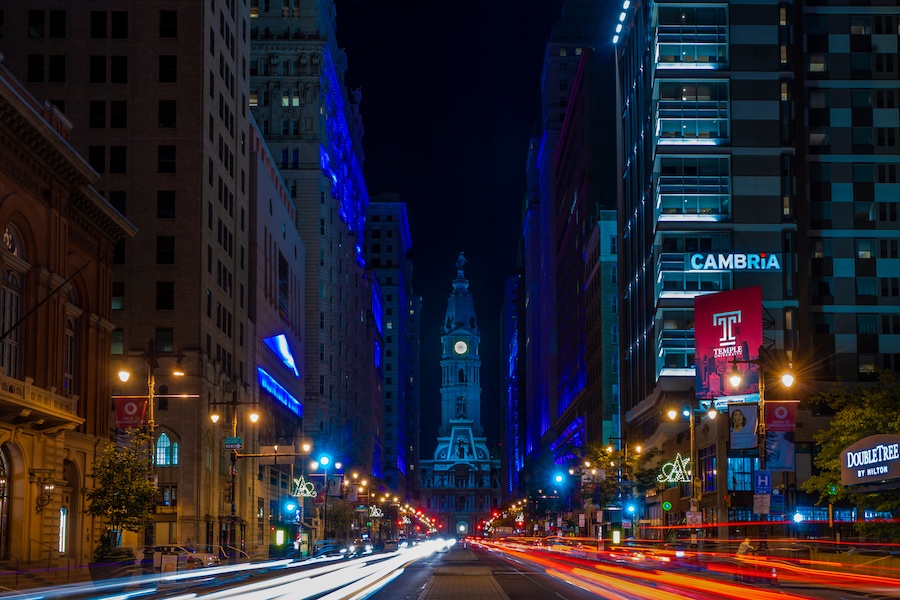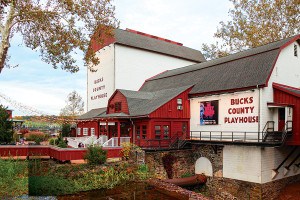Will Philly’s 2020 Real Estate Party Continue into 2021?
The real estate markets in both city and suburbs have been on a tear this year. Here's a look at some of the reasons why — and what's likely to influence them in the coming year.

The region’s real estate market lit up like Broad Street this year. Will it remain as active in 2021? | Photo: J. Fusco for Visit Philadelphia
2020 has been one horrible year in many ways, including in lots of areas of real estate. For the residential real estate market in the Philadelphia area, however, it was a very good year.
With consumers here and across the country saving more after COVID-19 deprived them of things to buy, many decided to splurge on real estate. And super-cheap debt made splurging easier.
Once Pennsylvania lifted its restrictions on real estate sales in May, house sales in both the city and its suburbs took off like rockets. Over the summer, inventory and days on market plummeted to levels not seen in anyone’s memory. Houses continue to fly off the shelves even now.
Add to that New Yorkers moving here in search of more for less, and you had a very buoyant real estate market this year.
“My estimation of the pandemic is that it exacerbated existing trends,” says Lauren Gilchrist, senior vice president and senior director of research at JLL Philadelphia.
One of the most notable of those trends was those New Yorkers moving to the Philadelphia area. Gilchrist points out that sales were already weakening at the top of the New York City market and that the ”sky-high condos” weren’t finding buyers the way they had been: “The pandemic threw gasoline on the fire of the overbuilt high-end condo market in New York.” Combine this with pandemic-inspired reports of “the end of New York,” and the roughly decade-old pattern of net migration from New York to Philadelphia only grew.

City houses with lots of indoor and outdoor space, like this SocietyHill townhouse, should prove especially appealing in the coming months. | Bright MLS image via Compass
Another trend that COVID exacerbated was a hardy American perennial: the search for more space. The majority of non-rural Americans live in the suburbs, and this shows no sign of changing anytime soon. Several factors tend to lead young adults who fall in love with city life after graduating from college toward suburban houses with bigger yards as they turn from couples into families.
The millennial generation is now at family-making age, and the COVID-driven desire for social distancing simply intensified that tendency to leave the city. “Demographically, the bulk of the [younger] population was reaching the point where they would naturally, say, in the next three to five years, consider moving to the suburbs because of family formation,” says Sara Doelger, principal at Argosy Real Estate Partners.
The city market, however, hasn’t weakened significantly as a result. Both Generation Z homebuyers and those New Yorkers seeking more bang for the buck have kept houses moving in the city. “In Graduate Hospital, I’ve seen houses fly off the market in three weeks,” says Gilchrist, who lives there.
The city rental market has also held up well this year. According to data from RENTCafé, Philadelphia bucked a trend of both fewer people renting and more renters moving out of the city in 2020. Overall, rental applications rose by eight percent, and the number of renters moving into the city from elsewhere rose by four percent, while those who left it fell by one percent.
According to RENTCafé spokesperson Daniel Coste, most of those moving into Philly apartments in 2020 were younger people who lived in other cities: 53 percent of the new arrivals were urban dwellers, up six points from the year before, and their median age was 28.
And they found a growing supply of apartments to choose from. Data from RENTCafé sibling Yardi Matrix shows that 1,843 new units were added to the stock of city apartments in 2020. The suburban inventory grew even more, with 2,757 units coming on line this year. Percentage-wise, the city slightly outpaced the suburbs in unit growth.
Because of the increased supply, rents in the city fell by 0.6 percent in 2020, slightly more than the national average decline of 0.5 percent.
One other possible reason why both rental and sales activity held up well here: The city managed to recover some of the jobs lost in the pandemic’s first wave as the year progressed. Yardi Matrix manager of business intelligence Doug Ressler says the region recovered 56 percent of the jobs initially lost in March, when the COVID lockdowns abruptly threw the economy into reverse.

Yardi Matrix predicts that occupancy will remain high in apartment complexes across the region in the year ahead. The company sees strong rent growth in the suburbs and modest growth in the city.
So it appears that one of this region’s under-appreciated strengths — an economy that neither flies high nor crashes hard — also helped local real estate remain strong in 2020. Will this continue into next year?
One factor that might help keep the city market strong, according to Gilchrist, is the likely return of the office as an actual worksite. During this year’s PwC/ULI Philadelphia Real Estate Forecast seminar, she presented figures showing that the overwhelming majority of office workers — 78 percent — expect to return to the office at least part of the time once the pandemic passes. The largest share, 31 percent, expects to work in the office for two or three days and from home the rest of the time.
And since, if given a choice, most office workers would prefer to live near where they work, this should be good news for two local submarkets especially: Center City, which remains the region’s biggest employment center, and King of Prussia, its biggest edge city and the region’s number two job hub.
Doelger says, “There are very few cities where people live downtown. Philadelphia has always had a very large downtown residential population, but Philadelphia over the past two decades has become an incredibly desirable place to live from a lifestyle perspective. Relative to other urban centers [on the East Coast], we have less density, lots of parks and open spaces, and fantastic culture.”
But since working from home is here to stay. and because homeschooling is likely to continue for much of the coming year, the types of houses and apartments people will probably shift somewhat. Buyers will want houses with enough rooms to turn one into a workplace, and COVID-driven concerns over health and wellness should make houses with yards even more prized than they are already.
That last concern, especially, should continue to bolster the suburban market hereabouts. If the city’s ace in the hole is the large supply of housing in its heart, then the suburbs’ strengths lie in the many walkable communities that dot this region, enabling residents to combine exercise with their daily needs.
The rental market should likewise remain strong. While Yardi Matrix’s Ressler says the region will add some 12,000 units to its apartment inventory over the next two years, he also predicts rents will rise modestly in the city and a good deal more in the suburbs.
And as long as mortgages remain cheap and savings high, the real estate party in Philly should continue into 2021, most likely with still more New Yorkers joining in the fun.


